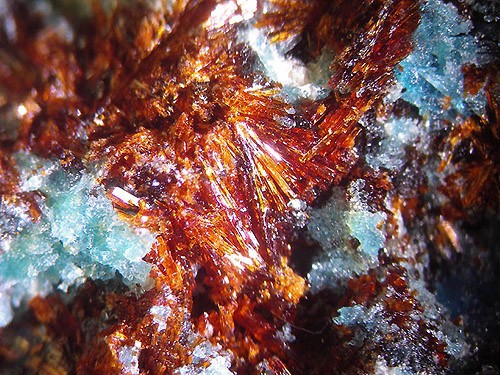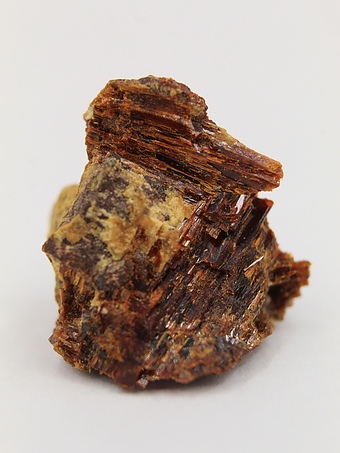Amarantite
A valid IMA mineral species - grandfathered
This page is currently not sponsored. Click here to sponsor this page.
About Amarantite
Formula:
Fe3+2(SO4)2O · 7H2O
Colour:
Amaranth-red to brownish red and red-orange
Lustre:
Vitreous
Hardness:
2½
Specific Gravity:
2.189 - 2.286
Crystal System:
Triclinic
Name:
From the Greek αμάραντος = amaranth, an imaginary red undying flower, in allusion to its colour.
This page provides mineralogical data about Amarantite.
Unique Identifiers
Mindat ID:
182
Long-form identifier:
mindat:1:1:182:9
GUID
(UUID V4):
(UUID V4):
1e7cb68b-e1ba-4275-bd99-c1d1110db886
IMA Classification of Amarantite
Approved, 'Grandfathered' (first described prior to 1959)
IMA Formula:
Fe3+2O(SO4)2 · 7H2O
Classification of Amarantite
7.DB.30
7 : SULFATES (selenates, tellurates, chromates, molybdates, wolframates)
D : Sulfates (selenates, etc.) with additional anions, with H2O
B : With only medium-sized cations; insular octahedra and finite units
7 : SULFATES (selenates, tellurates, chromates, molybdates, wolframates)
D : Sulfates (selenates, etc.) with additional anions, with H2O
B : With only medium-sized cations; insular octahedra and finite units
31.9.3.1
31 : HYDRATED SULFATES CONTAINING HYDROXYL OR HALOGEN
9 : (AB)(XO4)Zq·xH2O
31 : HYDRATED SULFATES CONTAINING HYDROXYL OR HALOGEN
9 : (AB)(XO4)Zq·xH2O
25.10.17
25 : Sulphates
10 : Sulphates of Fe alone
25 : Sulphates
10 : Sulphates of Fe alone
Mineral Symbols
As of 2021 there are now IMA–CNMNC approved mineral symbols (abbreviations) for each mineral species, useful for tables and diagrams.
| Symbol | Source | Reference |
|---|---|---|
| Ama | IMA–CNMNC | Warr, L.N. (2021). IMA–CNMNC approved mineral symbols. Mineralogical Magazine, 85(3), 291-320. doi:10.1180/mgm.2021.43 |
Physical Properties of Amarantite
Vitreous
Transparency:
Transparent
Colour:
Amaranth-red to brownish red and red-orange
Streak:
Lemon-yellow
Hardness:
2½ on Mohs scale
Tenacity:
Brittle
Cleavage:
Perfect
On {010} and {100}, perfect.
On {010} and {100}, perfect.
Density:
2.189 - 2.286 g/cm3 (Measured) 2.14 g/cm3 (Calculated)
Optical Data of Amarantite
Type:
Biaxial (-)
RI values:
nα = 1.516 nβ = 1.598 nγ = 1.621
2V:
Measured: 30° , Calculated: 52°
Max Birefringence:
δ = 0.105

Image shows birefringence interference colour range (at 30µm thickness)
and does not take into account mineral colouration.
and does not take into account mineral colouration.
Surface Relief:
Moderate
Dispersion:
none
Pleochroism:
Visible
Comments:
X = colourless
Y = Light yellow
Z = Reddish brown
Y = Light yellow
Z = Reddish brown
Chemistry of Amarantite
Mindat Formula:
Fe3+2(SO4)2O · 7H2O
Elements listed:
Crystallography of Amarantite
Crystal System:
Triclinic
Class (H-M):
1 - Pinacoidal
Space Group:
P1
Cell Parameters:
a = 8.9 Å, b = 11.56 Å, c = 6.64 Å
α = 95.55°, β = 90.52°, γ = 97.42°
α = 95.55°, β = 90.52°, γ = 97.42°
Ratio:
a:b:c = 0.77 : 1 : 0.574
Unit Cell V:
674.09 ų (Calculated from Unit Cell)
Z:
2
Morphology:
Crystals, to 2 cm, elongated along [001], with dominant {100} and {010}, and square cross section; also flattened [100] and striated on {001}; more than 60 forms recorded; typically in radiating or matted aggregates of needles; columnar or bladed.
Crystal Structure
Load
Unit Cell | Unit Cell Packed
2x2x2 | 3x3x3 | 4x4x4
Unit Cell | Unit Cell Packed
2x2x2 | 3x3x3 | 4x4x4
Show
Big Balls | Small Balls | Just Balls | Spacefill
Polyhedra Off | Si Polyhedra | All Polyhedra
Remove metal-metal sticks
Big Balls | Small Balls | Just Balls | Spacefill
Polyhedra Off | Si Polyhedra | All Polyhedra
Remove metal-metal sticks
Display Options
Black Background | White Background
Perspective On | Perspective Off
2D | Stereo | Red-Blue | Red-Cyan
Black Background | White Background
Perspective On | Perspective Off
2D | Stereo | Red-Blue | Red-Cyan
View
CIF File Best | x | y | z | a | b | c
CIF File Best | x | y | z | a | b | c
Rotation
Stop | Start
Stop | Start
Labels
Console Off | On | Grey | Yellow
Console Off | On | Grey | Yellow
Data courtesy of the American Mineralogist Crystal Structure Database. Click on an AMCSD ID to view structure
| ID | Species | Reference | Link | Year | Locality | Pressure (GPa) | Temp (K) |
|---|---|---|---|---|---|---|---|
| 0010666 | Amarantite | Susse P (1968) The crystal structure of amarantite, Fe2(SO4)2O*7H2O Zeitschrift fur Kristallographie 127 261-275 |  | 1968 | Quetena, Chile | 0 | 293 |
CIF Raw Data - click here to close
X-Ray Powder Diffraction
Image Loading
Radiation - Copper Kα
Data courtesy of RRUFF project at University of Arizona, used with permission.
Powder Diffraction Data:
| d-spacing | Intensity |
|---|---|
| 11.25 Å | (FFF) |
| 8.69 Å | (FFF) |
| 5.16 Å | (mF) |
| 4.98 Å | (mF) |
| 3.57 Å | (FF) |
| 3.11 Å | (F) |
| 3.05 Å | (FF) |
Geological Environment
Paragenetic Mode(s):
| Paragenetic Mode | Earliest Age (Ga) |
|---|---|
| Stage 7: Great Oxidation Event | <2.4 |
| 47a : [Near-surface hydration of prior minerals] | |
| 47b : [Sulfates and sulfites] |
Geological Setting:
A secondary mineral formed especially in arid climates.
Type Occurrence of Amarantite
General Appearance of Type Material:
massive
Place of Conservation of Type Material:
BAF, 44700.
Associated Minerals at Type Locality:
Reference:
Frenzel A (1888) XVII. Mineralogisches. 10. Hohmannit. 11. Amarantit. 12. Vorkommnisse von Ehrenfriedersdorf. Mineralogische und Petrographische Mittheilungen 9, 397-400
Synonyms of Amarantite
Other Language Names for Amarantite
Common Associates
Associated Minerals Based on Photo Data:
| 20 photos of Amarantite associated with Chalcanthite | CuSO4 · 5H2O |
| 13 photos of Amarantite associated with Copiapite | Fe2+Fe3+4(SO4)6(OH)2 · 20H2O |
| 6 photos of Amarantite associated with Hohmannite | Fe3+2(SO4)2O · 8H2O |
| 4 photos of Amarantite associated with Eriochalcite | CuCl2 · 2H2O |
| 3 photos of Amarantite associated with Alunogen | Al2(SO4)3 · 17H2O |
| 3 photos of Amarantite associated with Kröhnkite | Na2Cu(SO4)2 · 2H2O |
| 2 photos of Amarantite associated with Fibroferrite | Fe3+(SO4)(OH) · 5H2O |
| 2 photos of Amarantite associated with Metahohmannite | Fe3+2(SO4)2O · 4H2O |
| 1 photo of Amarantite associated with Butlerite | Fe3+(SO4)(OH) · 2H2O |
| 1 photo of Amarantite associated with Melanterite | Fe2+(H2O)6SO4 · H2O |
Related Minerals - Strunz-mindat Grouping
| 7.DB.05 | Aubertite | CuAl(SO4)2Cl · 14H2O |
| 7.DB.05 | Magnesioaubertite | (Mg,Cu)Al(SO4)2Cl · 14H2O |
| 7.DB.05 | Svyazhinite | (Mg,Mn2+,Ca)(Al,Fe3+)(SO4)2F · 14H2O |
| 7.DB.10 | Khademite | Al(SO4)F · 5H2O |
| 7.DB.10 | Rostite | Al(SO4)(OH) · 5H2O |
| 7.DB.15 | Jurbanite | Al(SO4)(OH) · 5H2O |
| 7.DB.20 | Minasragrite | (V4+O)(SO4) · 5H2O |
| 7.DB.20 | Orthominasragrite | (V4+O)(SO4) · 5H2O |
| 7.DB.20 | Anorthominasragrite | (V4+O)(SO4) · 5H2O |
| 7.DB.25 | Bobjonesite | (V4+O)(SO4) · 3H2O |
| 7.DB.27 | Karpovite | Tl2VO(SO4)2(H2O) |
| 7.DB.30 | Hohmannite | Fe3+2(SO4)2O · 8H2O |
| 7.DB.30 | Metahohmannite | Fe3+2(SO4)2O · 4H2O |
| 7.DB.35 | Aluminocopiapite | Al2/3Fe3+4(SO4)6(OH)2 · 20H2O |
| 7.DB.35 | Calciocopiapite | CaFe3+4(SO4)6(OH)2 · 20H2O |
| 7.DB.35 | Copiapite | Fe2+Fe3+4(SO4)6(OH)2 · 20H2O |
| 7.DB.35 | Cuprocopiapite | Cu2+Fe3+4(SO4)6(OH)2 · 20H2O |
| 7.DB.35 | Ferricopiapite | Fe3+0.67Fe3+4(SO4)6(OH)2 · 20H2O |
| 7.DB.35 | Magnesiocopiapite | MgFe3+4(SO4)6(OH)2 · 20H2O |
| 7.DB.35 | Zincocopiapite | ZnFe3+4(SO4)6(OH)2 · 18H2O |
Other Information
Notes:
Decomposed by cold water with the formation of an insoluble basic salt. Soluble in HCl.
Health Risks:
No information on health risks for this material has been entered into the database. You should always treat mineral specimens with care.
Internet Links for Amarantite
mindat.org URL:
https://www.mindat.org/min-182.html
Please feel free to link to this page.
Please feel free to link to this page.
Search Engines:
External Links:
Mineral Dealers:
References for Amarantite
Reference List:
Bandy, Mark C. (1938) Mineralogy of three sulphate deposits of northern Chile. American Mineralogist, 23 (11) 669-760
Cesbron, Fabien (1964) Contribution à la Minéralogie des sulfates de fer hydratés. Bulletin de Minéralogie, 87 (2) 125-143 doi:10.3406/bulmi.1964.5721
Süsse, P. (1968) The crystal structure of amarantite, Fe2(SO4)2O·7H2O. Zeitschrift für Kristallographie - Crystalline Materials, 127 (1) 261-275 doi:10.1524/zkri.1968.127.1-4.261
Scordari, F. (1978) The crystal structure of hohmannite, Fe2(H2O)4[(SO4)2O]·4H2O and its relationship to amarantite, Fe2(H2O)4[(SO4)2O]·3H2O. Mineralogical Magazine, 42 (321) 144-146 doi:10.1180/minmag.1978.042.321.24
Localities for Amarantite
Locality List
 - This locality has map coordinates listed.
- This locality has map coordinates listed.
 - This locality has estimated coordinates.
ⓘ - Click for references and further information on this occurrence.
? - Indicates mineral may be doubtful at this locality.
- This locality has estimated coordinates.
ⓘ - Click for references and further information on this occurrence.
? - Indicates mineral may be doubtful at this locality.
 - Good crystals or important locality for species.
- Good crystals or important locality for species.
 - World class for species or very significant.
(TL) - Type Locality for a valid mineral species.
(FRL) - First Recorded Locality for everything else (eg varieties).
- World class for species or very significant.
(TL) - Type Locality for a valid mineral species.
(FRL) - First Recorded Locality for everything else (eg varieties).
All localities listed without proper references should be considered as questionable.
Argentina | |
| Angelelli et al. (1941) |
Australia | |
| Noble R.J et al. (1983) |
Canada | |
| Zodrow (1989) |
Chile | |
| Palache et al. (1951) |
| Kampf +5 other references | |
| Bulletin de Minéralogie 87 (1964) |
| Palache et al. (1951) | |
| Palache et al. (1951) |
| Palache et al. (1951) |
| Palache et al. (1951) |
| Samples analysed by Tony Kampf of LAC ... |
| Palache et al. (1951) |
| Peter G. Seroka collection |
Greece | |
| no description given yet] +1 other reference |
| Rieck et al. (2018) |
Iran | |
| Bariand et al. (1973) +1 other reference |
Italy | |
| Fernando Caboni et al. (2024) |
| Fernando Caboni et al. (2024) | |
| Quagliarella (1966) |
Norway | |
| Selbekk et al. (2010) |
Peru | |
| Atchley (1956) |
Russia | |
| Kudrin et al. (2021) |
Slovakia | |
| Szakáll et al. (2014) |
| Duda |
Spain | |
| Jose Miguel Sola collection |
USA | |
| Schairer (1924) +1 other reference |
| Schairer (1924) +2 other references | |
| Northrop et al. (1996) |
| Northrop et al. (1996) | |
| Roberts et al. (1965) |
Quick NavTopAbout AmarantiteUnique IdentifiersIMA Classification Classification Mineral SymbolsPhysical Properties Optical Data Chemistry Crystallography Crystal StructureX-Ray Powder DiffractionGeological EnvironmentType Occurrence SynonymsOther LanguagesCommon AssociatesStrunz-MindatOther InformationInternet Links References Localities Locality List





 symbol to view information about a locality.
The
symbol to view information about a locality.
The 



Queténa Mine, Toki Cu deposit, Chuquicamata District, Calama, El Loa Province, Antofagasta, Chile